I went to the world's first cheese conveyor belt and learned you can have too much of a good thing
Anneta Konstantinides

- I visited the world's first cheese conveyor belt, located at Pick & Cheese in London.
- I went in with the mission to try all 26 different plates of cheese, but only made it to 18.
I set off for Pick & Cheese on a surprisingly sunny January day.
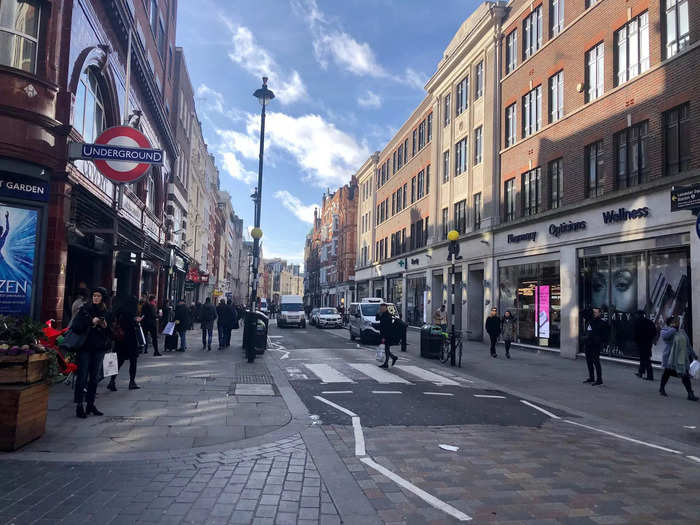
I left Insider's UK office in London's Shoreditch neighborhood (which I was visiting from New York) and took two tubes — as the British would say — to get to the city's Covent Garden district.
As the sun shone down on the cobbled streets lined with vintage stores, English pubs, and high-end boutiques, I couldn't help but feel charmed. The iconic words of Joey Tribbiani rang in my head: "London, baby!"
After just a few minutes of walking from the tube station, Google Maps informed me I had reached my destination.
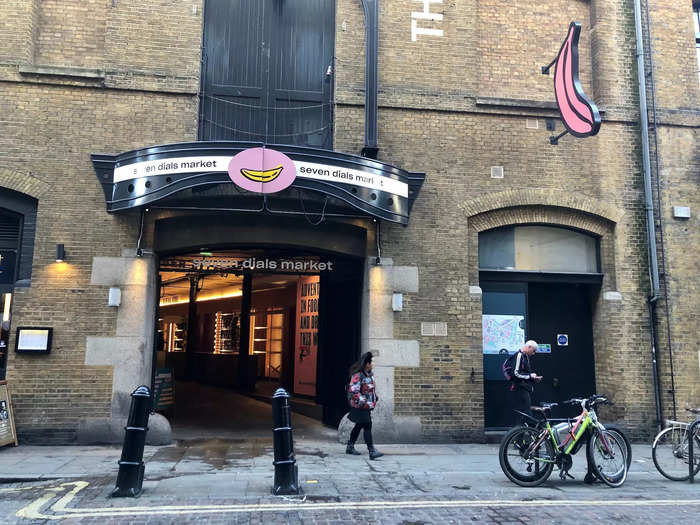
A hot-pink banana greeted me as I walked into Seven Dials Market, which is filled with different restaurants and food stalls. There's everything from a deli and Mexican cuisine to Japanese soul food and truffle burgers. It all looked amazing, but I was there for one thing and one thing only: the world's first cheese conveyor belt.
My stomach grumbled a complaint as I looked around, angry that it was past noon and I had yet to eat anything all day. But I was about to try and eat 26 plates of cheese. I needed all the space I could get.
As I walked into the market, I swore I could already smell the first whiffs of cheese. I followed my nose and soon found myself right in front of the conveyor belt.
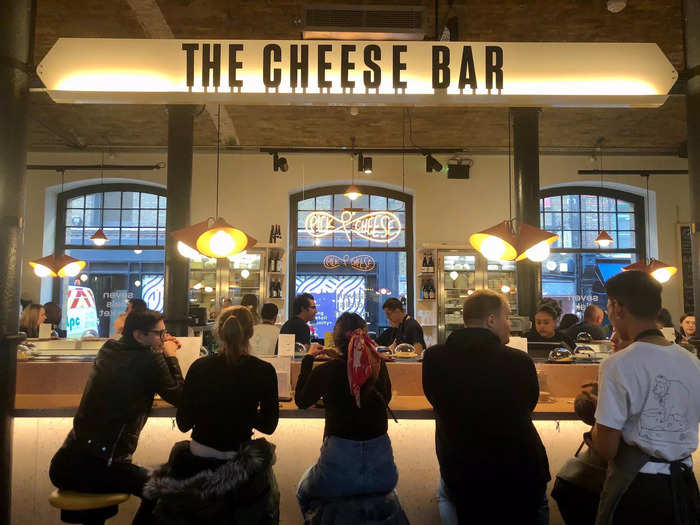
The bar was almost completely full on a Tuesday for lunch, which didn't shock me. I had seen the conveyor belt popping up on Instagram and Facebook for months since Pick & Cheese first opened in September 2019. Cheese has long been social-media catnip, filling our Instagram Explore pages and racking up tens of thousands of likes with clips of beautiful burrata balls and envy-inducing cheese boards.
But I was happily surprised to find that Pick & Cheese felt far more laid-back than I had expected for an Insta-destination. I saw people of all ages happily sitting on their stools and quietly chatting, some sipping a glass of red wine for a midday pick-me-up. The low lights gave the bar a relaxed vibe. There was nary a camera flash in sight.
As I waited for my friend to arrive, I decided to get a closer look at the main attraction: the conveyor belt.
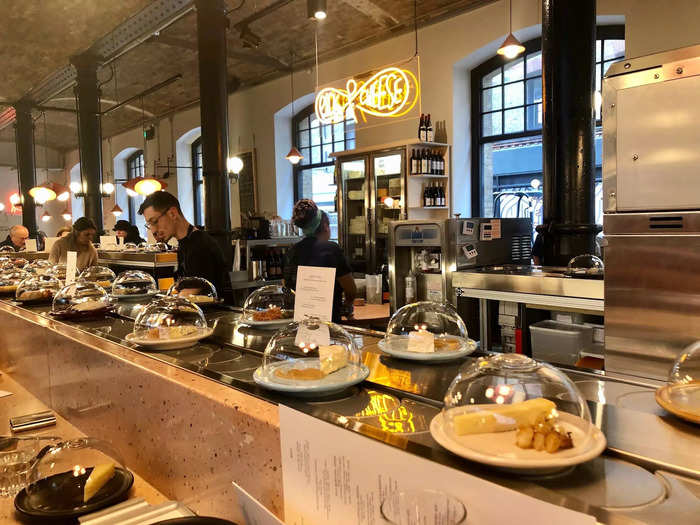
My excitement only continued to build (and my stomach let out another grumble) as I watched the floating plates rotate around the bar. I immediately recognized some of the cheeses and meats — a cheddar here, a salami there — but struggled to identify others.
Mathew Carver, the owner of Pick & Cheese, told me that he wanted to create a place that would inspire people to try different cheeses outside of their usual comfort zone.
"When we started the business, the idea was to serve really great British cheese — the kind of stuff you get in high-end cheese shops — but serve it in a more fun and engaging way," he said. "To make it a bit more accessible."
And Carver said he realized that cheese was naturally well-suited for a conveyor belt bar.
"Cheese is supposed to be served at room temperature, so going around the belt it's the perfect temperature and ready to eat," he added. "And it can sit outside for four hours without damaging the quality."
Pick & Cheese serves 26 different plates of British cheeses and meats, which range in price from $3.60 (£2.75) to $7.99 (£6.10).
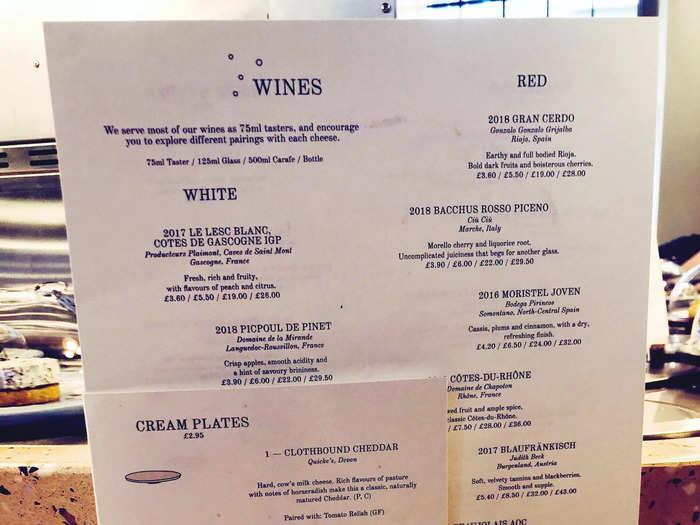
Each plate of cheese comes with a pairing (created by Carver, his cheesemonger, and his head chef), while the meat plates are served with baby pickles. As with sushi conveyor belts, the price of each dish is represented by the color of its plate.
When I told Carver that I was surprised he was able to keep prices so low for such high-end cheese, he credited the restaurant's conveyor belt system.
"We don't have as many costs when it comes to staffing because the conveyor belt is doing the whole work," he said. "We also buy all our cheese directly from the producers, so we kind of cut out the middleman."
My friend Ekin arrived and a waiter seated us at the last two empty stools at the bar. He then showed us the tray where we were meant to stack our plates.
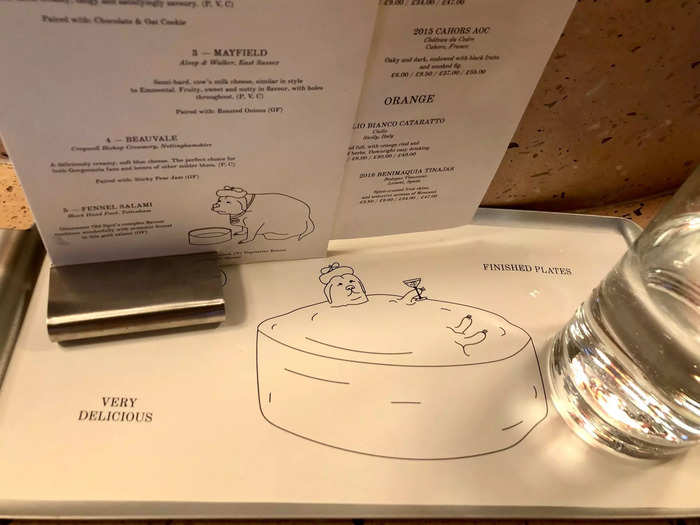
The tray was decorated with a drawing of Pick & Cheese's mascot, a very large dog named Bert, soaking in a huge vat of cheese.
I would soon know exactly how that felt.
My spirits were high as I grabbed our first two plates of cheese.
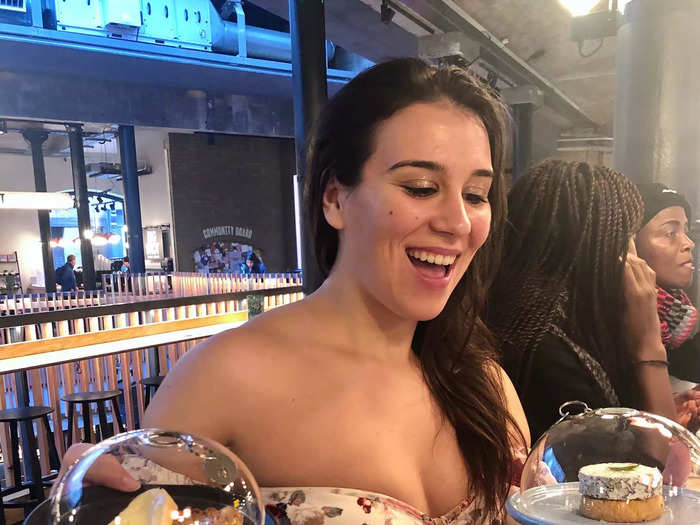
Ekin and I had no strategy when it came to our mission. We didn't even plan how much of each plate we were going to eat. We were just going to keep picking up new plates of cheese, starting with the ones that intrigued or excited us the most.
I grabbed a $5.77 (£4.40) cheese called Driftwood and a $4.92 (£3.75) cheese called Burwash Rose.
Driftwood is a soft goat cheese from Somerset, England, that has won multiple accolades in the World Cheese Awards over the last few years.
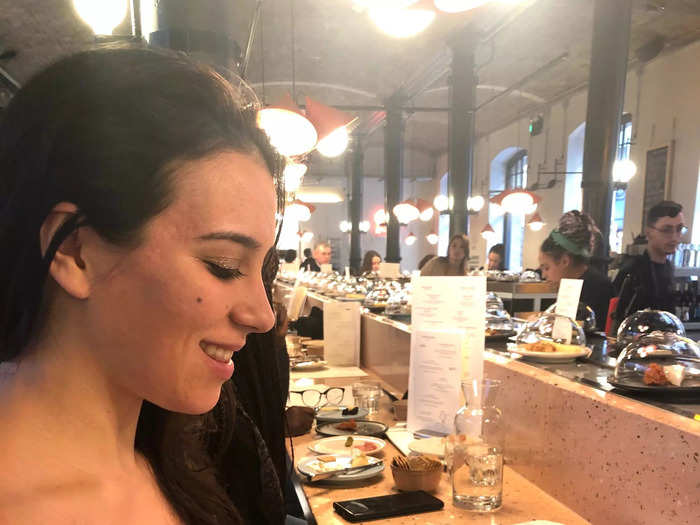
The creamy cheese, which is produced by White Lake Cheese, was paired with a rosemary shortbread and a drizzle of honey.
I thought the presentation of Driftwood was the most beautiful of all the plates we ate. I loved the sprigs of rosemary on top of the cheese, and I thought the way it was served made the dish look far more expensive than its price tag.
Both Ekin and I were also huge fans of the taste. The cheese was as creamy as a Camembert and the rosemary shortbread helped cut through its earthy notes, adding more depth to its flavor. We wiped our first plate clean with ease.
"I'm a massive fan," Ekin told me, speaking of the shortbread, between bites. "It lends a lovely sweetness."
Burwash Rose, a semi-soft cheese from Sussex, England, was one of Ekin's favorites.
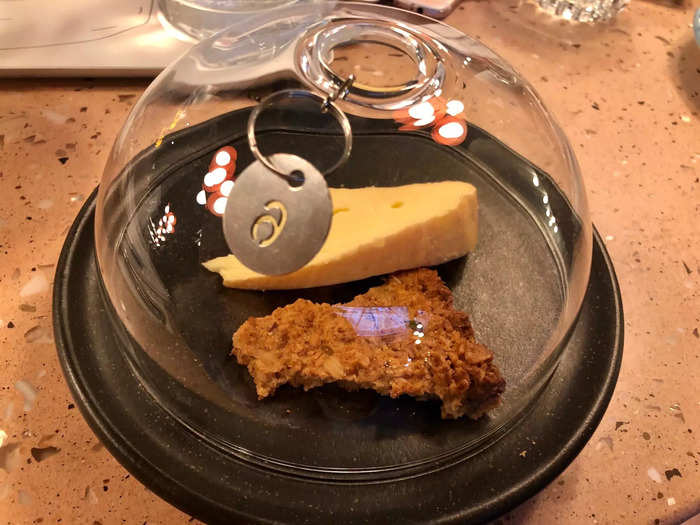
The cheese, produced by the Traditional Cheese Company, was served with a pistachio and orange flapjack, a popular type of oat bar in the UK.
Ekin couldn't get enough of the flapjack, whereas I thought it took away from the cheese's rich taste. She was more than happy to finish the dish as I turned my attention to the next one.
With our first two dishes down, Ekin and I started to get confident. Really confident.
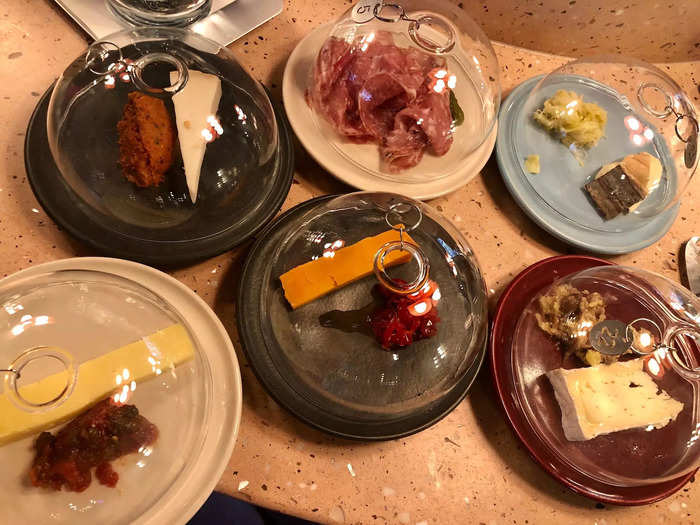
We pulled six plates off the conveyor belt, ready to dive deep into the world of cheese.
We decided to go for a mix of soft and hard cheeses, and I added a $3.88 (£2.95) plate of fennel salami to the group as well.
Our spirits were so high that we decided to take another two plates off the belt.
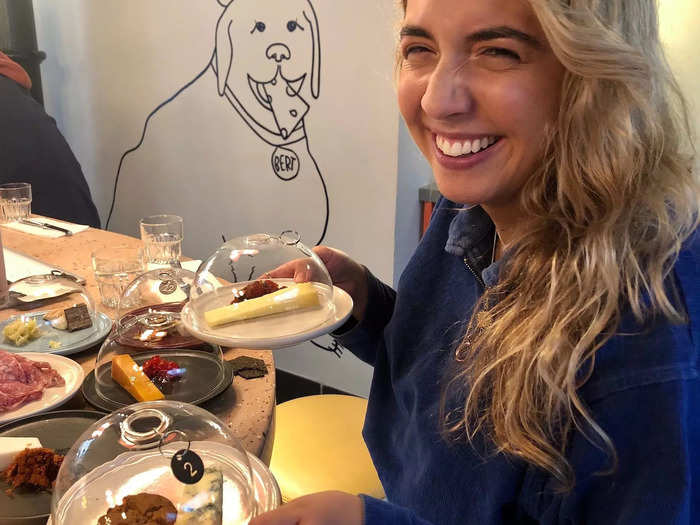
Our tiny space at the bar was now completely covered in blue, gray, and cream plates. People were staring, but we weren't fazed. We loved cheese. We needed cheese.
This was our calling.
As we went through our first few plates, I found there were so many different ways to build a perfect bite.
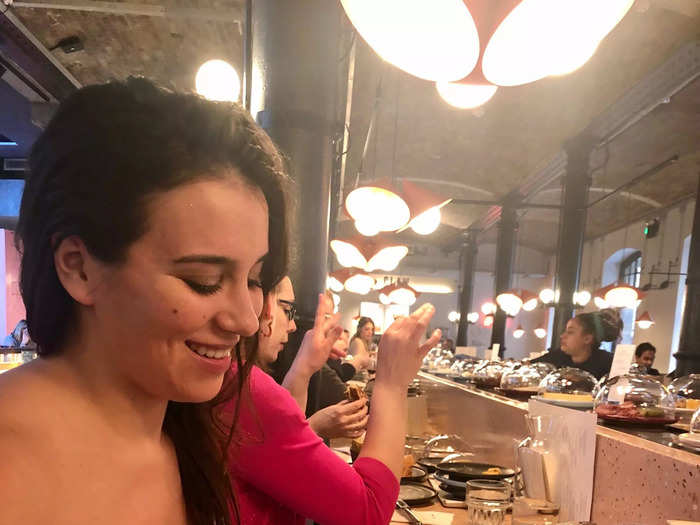
My strategy was to try the cheese by itself first, then try it with the pairing. Then, if need be, I would put it all on a cracker.
Even the crackers, which Pick & Cheese gives out for free, had different flavors that could add new dimensions to a cheese and its pairing. Some were plain — a blank canvas for more complex flavors — while others had an extra kick of saltiness or herbiness.
Plus, just having some extra crunch was great when it came to the really creamy cheeses.
We both enjoyed the Sparkenhoe Red Leicester and Baron Bigod cheeses, which had vastly different tastes but worked beautifully with their respective pairings.
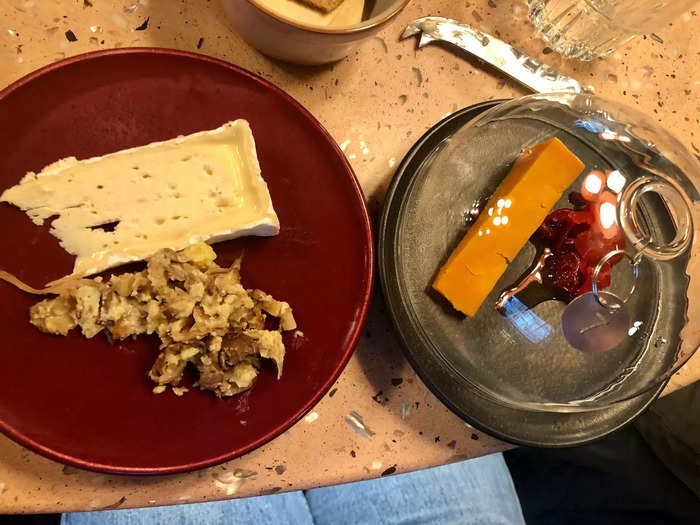
The Sparkenhoe Red Leicester, made by Sparkenhoe Farm in Leicestershire, England, cost $4.93 (£3.75) and was paired with candied chili peppers.
This was definitely in my top three of all the plates I ate. The candied chili peppers have a spiciness that comes in late, kicking your tongue just when you feel safe. The heat paired deliciously with the mild cheese without overpowering it.
The Baron Bigod is a creamy white soft cheese made at Fen Farm Dairy in Suffolk, England. The $6.90 (£5.25) cheese was paired with mushroom duxelle — a mixture of mushrooms, onions, herbs, and black pepper.
I have to admit, I was apprehensive about this dish. I would have never thought to serve mushrooms with cheese, but they danced together perfectly. The flavors of the mushroom duxelle and the earthy Baron Bigod were completely in sync. Ekin loved this dish so much, she did a little jig as she ate her first bite.
We also tried Stilton, a traditional English cheese, paired with a chocolate and oat cookie.
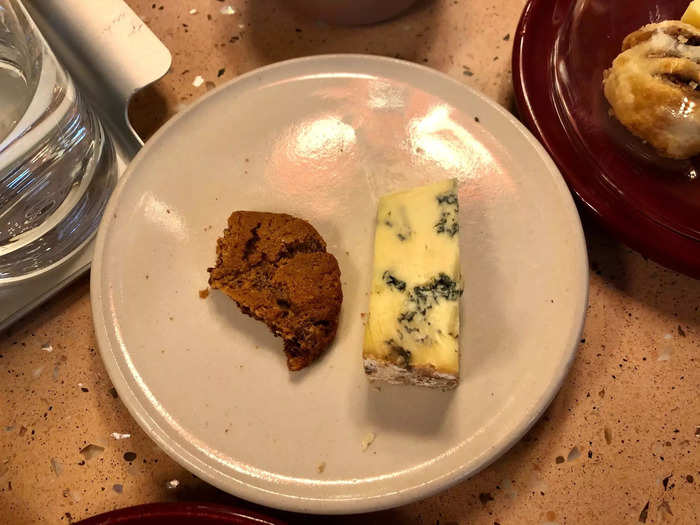
Carver told me that this dish, which costs $3.88 (£2.95), is popular among customers.
"I think people take it because they're like 'Oooh, chocolate chip cookie!' and then they're like 'This is a bit weird' and then they try it and they're like, 'God, that's really good,'" he said.
And we agreed. I thought the sweetness of the cookie helped cut through the rich flavor and pungent aftertaste of the blue cheese. I almost never go for blue cheeses, so I was surprised by how much I enjoyed the pairing.
The conveyor belt allowed us to easily mix and match different cheeses with different spreads, depending on our own individual preferences.
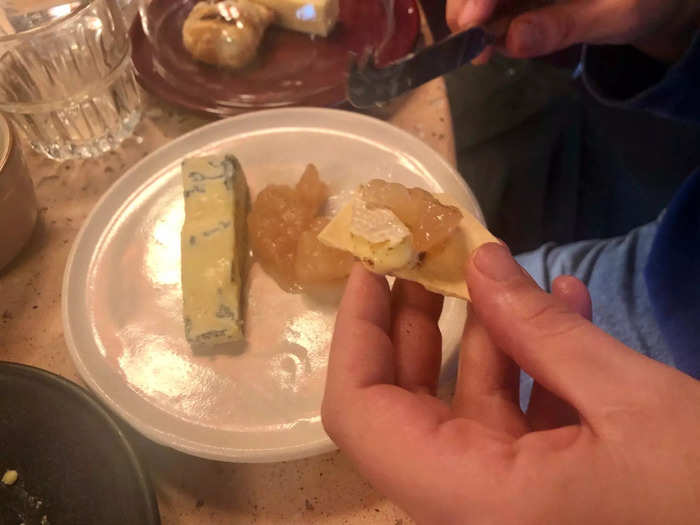
If there was a combination that didn't really hit for me or Ekin, we often would try the cheese or pairing with a different dish.
We loved the creamy $4.93 (£3.75) Maida Vale cheese, but were feeling too full for its brownie pairing. And while we adored the sticky pear jam that came with the $3.88 (£2.95) Beauvale cheese, we weren't in the mood for another blue cheese (this was our third). So, we paired the jam with the Maida Vale, and found it was a match made in heaven. The fruity jam went perfectly with the tangy cheese, which had an IPA-washed rind.
Somewhere around plate number 10 I began losing steam — fast.
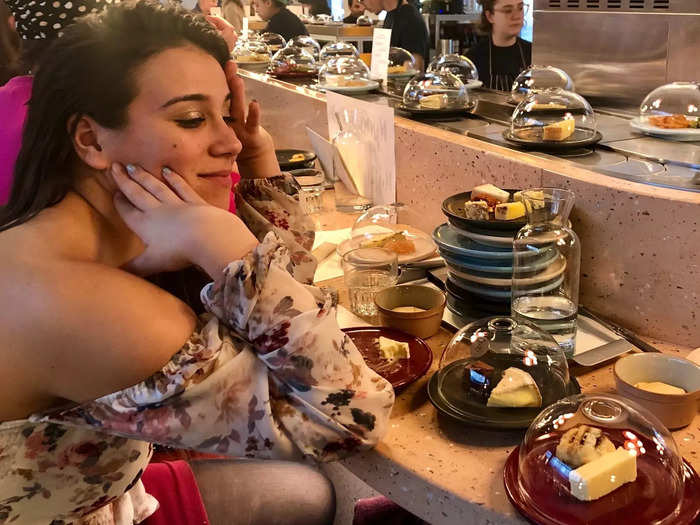
There were still a number of dishes in front of me, and many of them came with hefty pairings like a brownie or Eccles cake (a small, rich English cake often filled with currants). Why had I left so many blue cheeses for the end? Why had I finished so many of my first plates instead of taking just a few bites of each cheese? Why did I think I could ever do this!?
Maybe going in without a strategy wasn't such a great idea after all.
Ekin and I tried to stayed motivated with impromptu dance breaks.
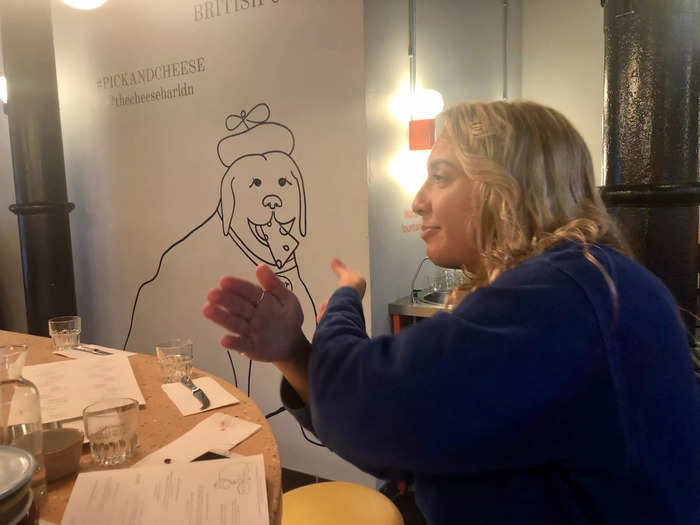
As if we didn't look weird enough with 10 plus plates of cheese in front of us, we kept spontaneously breaking out into jigs to inspire each other to keep going. It seemed like our words had begun to slur, even though neither of us had even sipped a single glass of wine.
"Can you get drunk on cheese?" I wondered to myself as I swung my arms in the air and did a little shoulder shimmy, trying to burn some calories.
Somewhere around dish 12 we also stopped using any of the crackers, trying to save as much space as possible for the cheese.
I tried to break things up with the meat plates, but they just made things harder.
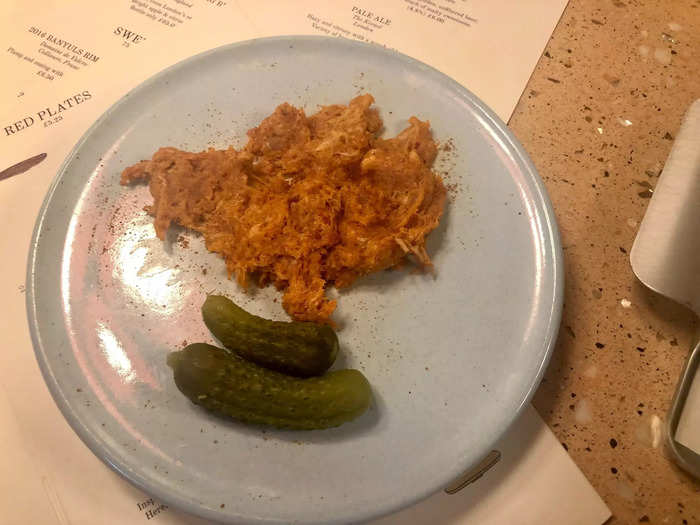
The salami and bresaola had been welcome escapes from all the cheese at the beginning of the journey, and I was sure I was going to love this Devil's Mortar.
The spreadable sausage, which is mixed with cayenne, chili, anchovy oil, and dried tomato, sounded right up my alley. But by the time I got to the $5.77 (£4.40) plate — one of my last — I could barely stomach two bites.
I looked at the dish forlornly, as if I had let down an old friend. I knew the end of my journey was near.
After plate 16, Ekin and I knew we couldn't go on much longer. We decided to end our journey with the cheesecake.
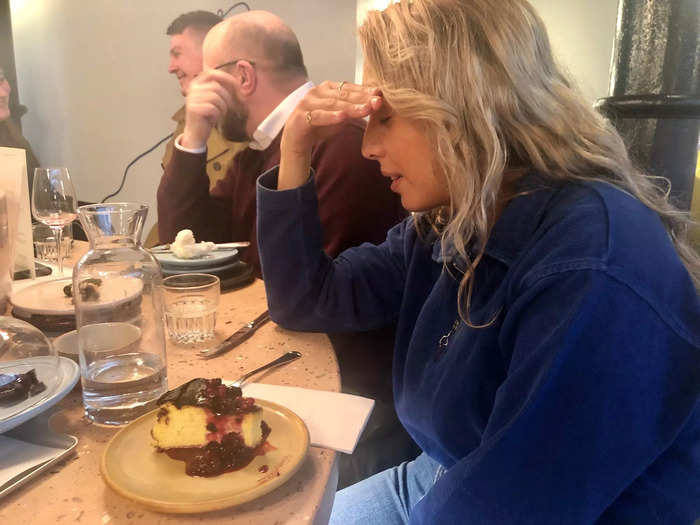
We took a few moments to emotionally prepare ourselves, convinced we would only be able to take a few bites.
But the $8.03 (£6.10) cheesecake was surprisingly light and fluffy, melting in our mouths with ease. The winter berries compote that was served on the side went perfectly with the cake, adding some extra bounce to its flavor. We couldn't believe it when we finished the entire plate.
We stacked up all our plates, putting the bits of cheeses and meats that we couldn't finish on the top.
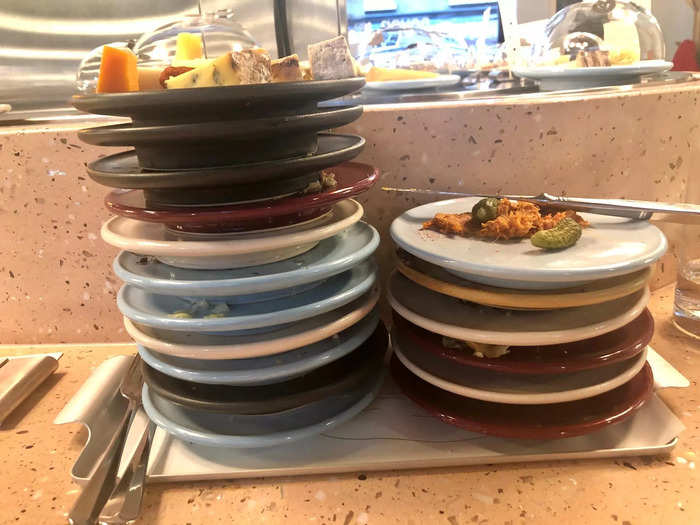
Together me and Ekin had gone through 17 out of 25 plates (one of the cheeses on the menu wasn't served that day).
We thought we were finished.
But that cheesecake must have had superpowers, because we got a second wind when we saw this plate coming down the conveyor belt.
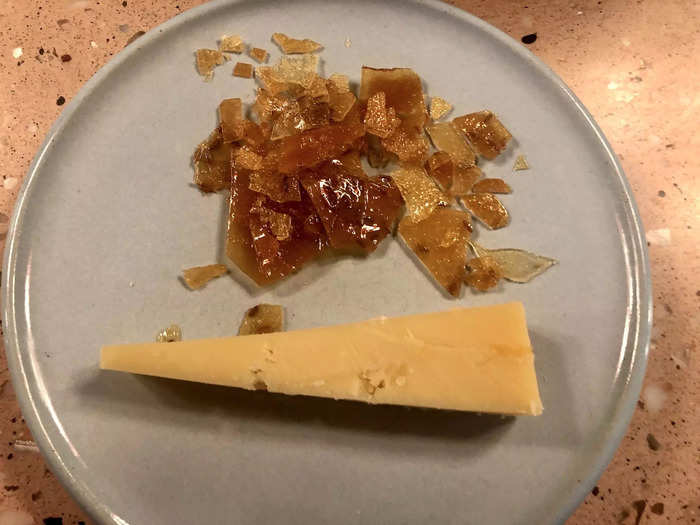
It wasn't so much the Cornish Gouda that caught my attention as its cumin praline pairing, which sparkled under the light like small shards of stained glass. Ekin and I looked at each other wordlessly. We knew we had to try it.
After one bite, we broke into a dance once again. But this time it wasn't because we were tired — it was because we loved the dish so much.
It may sound cliché, but the bite truly was an explosion of flavor. The cumin praline was both spicy and sweet, adding a ton of depth to the cheese and reminding me of an Indian curry. Its texture was so creative as well, the shards sharp enough to slice through chunks of the Gouda.
After nearly two-and-a-half hours, 18 plates, and $100.15 (£77) worth of cheese, our journey had finally come to an end.
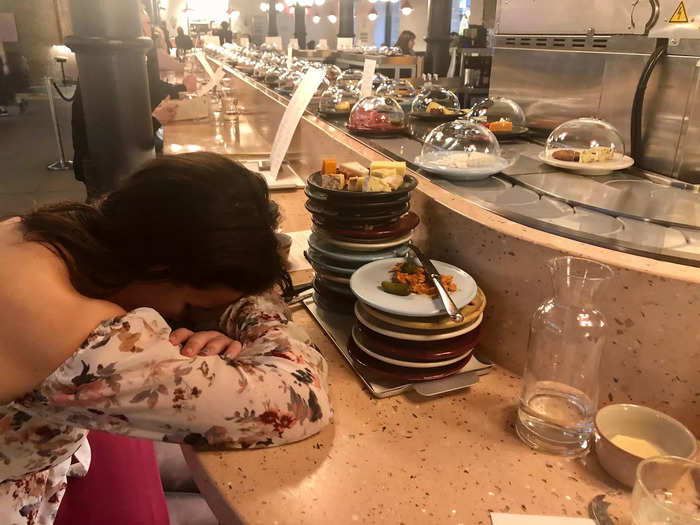
I was full and couldn't help but feel a little defeated. I only had seven dishes left to try. But I knew that if I kept going, I wouldn't really be able to taste the cheeses. And at the end of the day, that wasn't the point.
I had set out to learn more about cheese and find out whether the conveyor belt was just an Instagram gimmick. And I had found my answers.
The conveyor belt helped me expand my horizons and try varieties of cheese that I would never usually go for.
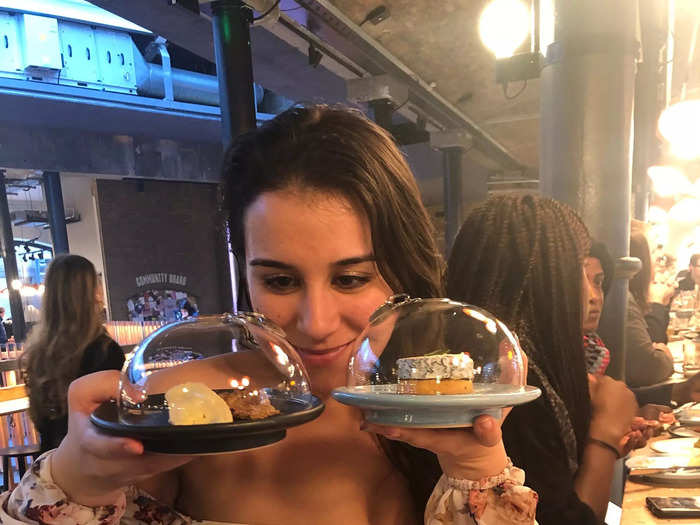
Carver told me that he decided to find a way to make high-end cheese feel more accessible after customers at his other London restaurant The Cheese Bar — which is dedicated to hot cheese dishes — kept asking him for advice.
"In the restaurant we have this big board in the back that lists all the cheeses that we sell and where they come from," he said. "People always used to come in and say that they would like to be able to assemble their own cheese board or pick which cheeses they wanted to try. So we wanted to try and come up with a way where people could come in and pick different cheeses, try different cheeses, and make their own cheese boards."
Carver also found that the conveyor belt was a great way to give people a chance to sample high-end cheeses that they might not be able to afford from a fromagerie.
"There are some cheeses here where, if you go to a cheese shop, it's like £100 to buy," he said. "Here it's like £5 on the belt."
I learned a lot about my own palette and what kind of cheese pairings work for me. And, most importantly, I had a ton of fun.
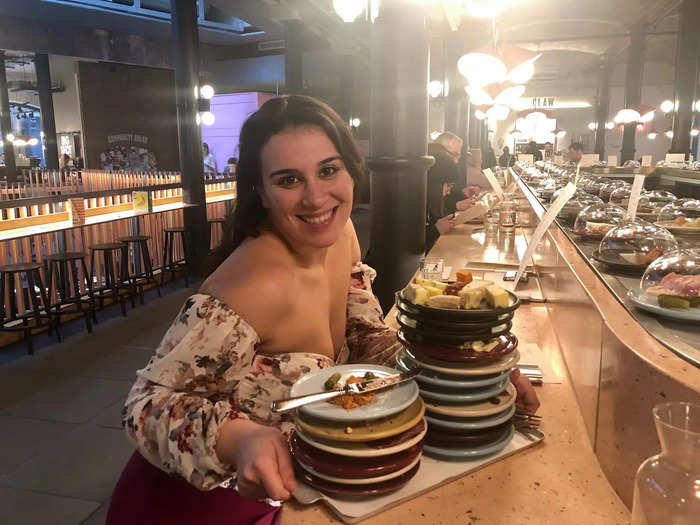
I'm not sure if the embrace of wine and cheese is a millennial thing, or something I'm just noticing as I get older. But there have been times where it's felt like being able to pick a good cheese for a picnic or friend's grazing board is the marker of adulthood. I can't tell you how many times I've sat in front of the cheese section at Trader Joe's, wondering if my selection will betray the fact I called my dad to ask how to change a light bulb last month.
But Pick & Cheese not only makes cheese feel as accessible as it used to be in our Lunchables, it makes it enjoyable, too. Because the plates are so affordable, I found it easier to take a risk with something new. And if you don't like the pairings, you can always mix and match, just as Ekin and I had. On top of all that, you get to learn about your own palette in a really easy and interactive way.
Pick & Cheese may feel like a gimmick to those who have become cynical in our Instagram-heavy age. But I found that the conveyor belt isn't just about a cool snap or boomerang, it's about reminding us that great cheese can be fun for everyone.
Maybe just not 18 plates of it.
Popular Right Now
Popular Keywords
Advertisement